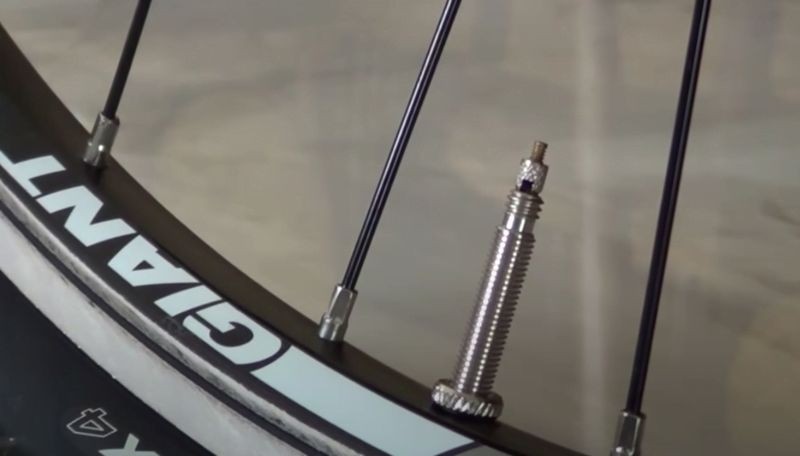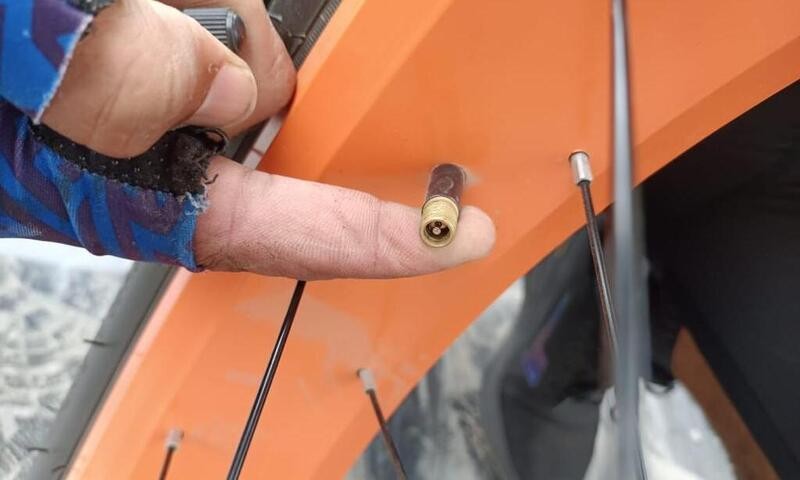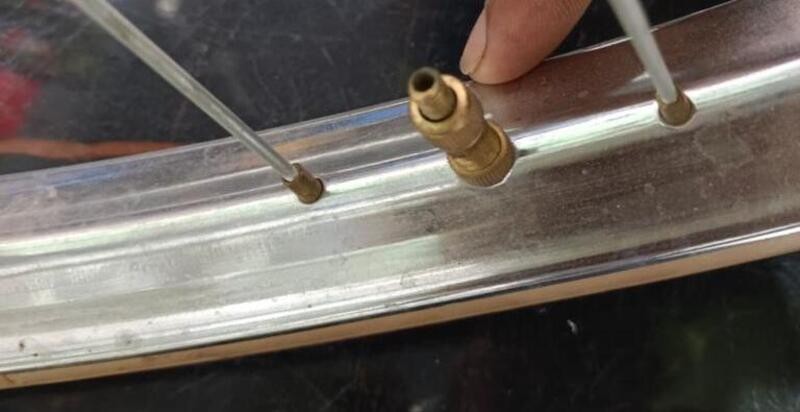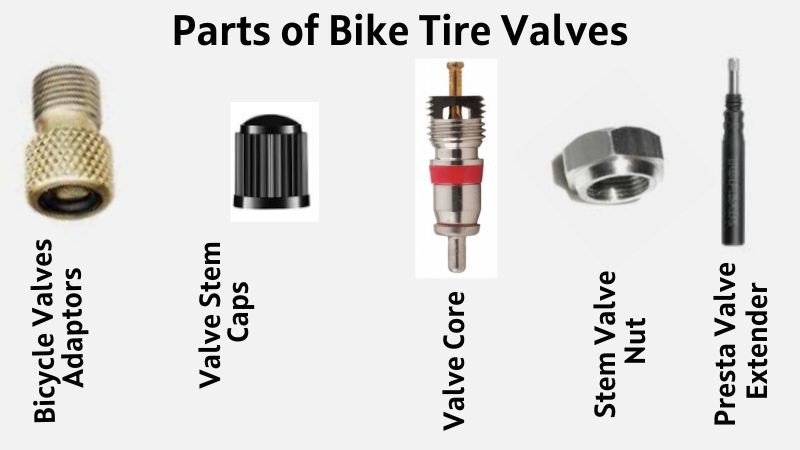Understanding the types of bike tire valves can save you from ruined rides down the road and ensure proper inflation
But sometimes, it’s hard to figure out which type of valve your bike has.
When pumping your bike tires, you might notice that it has a valve similar to what you see on cars, known as a Schrader valve. Or you may see a slender, exotic valve known as a Presta valve.
What is the difference between different types of bike tire valves, and how do these systems compare?
Find out everything you need to know about bike valve types, so you don’t get ever stuck in the future.
What are Bike Tire Valves
Bike tire valves, also known as inner tube valves, are a cycling essential that is often found on road bikes and mountain bikes.
Their sole purpose is to control the airflow in an inner tube which becomes air-filled post the cylinder is compressed. After that, the door can be forced open by air pressure.
As soon as the pump handle is pulled up again, the valve shuts off so that air cannot escape, and new air is drawn into the cylinder to continue the process.
The different Types of Bike Tire Valves and their benefits
Despite its unattractive appearance, the bicycle valve is crucial for letting air pressure into your tires and allowing you to pedal.
The rim of your bicycle will typically contain either a Presta valve or a Schrader valve, regardless of whether it is a road bike, mountain bike, electric bike, or gravel bike.
Riders will use a pump adapted for either Presta or Schrader valves to inflate the chosen valve. Tubeless valves and Dunlop valves are also available, but they are not as widely used as other bicycle valves outside Asia.
1. Presta Valves

A Presta valve, which is also known as a French valve or Sclaverand valve, is generally used in inner tubes for high-pressure road bikes and some mountain bicycles.
The valve comprises two parts: an outer stem and an inner body. It is also possible to see a lock nut to secure the valve stem to the wheel rims and a valve cap.
Valve stems are available in varying lengths and have a narrower diameter than Dunlop and Schrader valves (8 mm). The hole for the valve stem is usually the weakest point of a bicycle rim, but narrow wheels maintain sufficient strength, despite the smaller hole.
Mountain bikers have access to more different kinds and sizes of Presta valve tubes than they do to Schrader valve tubes.
For instance, an ultralight tube with a Presta valve is more likely to be found. If you need a heavy-duty tube, you will also find one Presta model at any nearby local bike shop very easily.
How to Inflate or Deflate Presta Valves Tire in Minutes
It can be challenging to fill a Presta valve with air for the first time. To begin with, remove the black dust cover from the top of the valve. Don’t lose this. Set it aside somewhere safe. Turn the brass cap at the top of the valve to the left and unscrew it.
You should hear and feel air escape from the valve when you press down the top with the brass cap unscrewed.
As a general rule, Presta valves are threaded throughout their length. Lock nuts are located at the bottom of valves to hold them in place.
Some tubes do not feature this lock nut because they are smooth. Pumping a flat tube can be done with either style, but using a Locknut Presta valve is easier because it holds the valve in place.
Presta valves can be inflated by removing the dust cap, unscrewing the brass cap, sliding a pump head onto the valve as far as it will go, and flipping up the lever on the pump.
Inflate your tire until it is fully inflated. Now remove the pump, screw back the brass cap, and replace the black dust cap that covers it.
Once you’ve done that, you are all set to go.
The Benefits of Utilizing Presta Valves for Optimal Tire Performance
There are several reasons why cyclists prefer Presta valves for their high-end road and track bikes. Some of the major ones are listed below for your reference:
1. A positive lock nut provides a seat seal.
2. Several different valve lengths are available, which can be helpful if you run deep rims.
3. Bicycles fitted with Presta valves offer superior air pressure control so cyclists can optimize their rides.
4. Designed to be light and durable, these valves can handle the rigors of cycling without adding additional weight.
5. Unlike Schrader valves, these valves usually have a smaller opening, making them ideal for tires and tubes with a narrower width.
The Drawbacks of Using Presta Valves: A Closer Look
1. It is not possible to replace the valve core.
2. When bent, threaded metal stems can snap off.
3. Valve needs an adapter to be inflated with an automotive air compressor.
2. Schrader Valves

A Schrader valve is typically wider and shorter than a Presta valve. They are the types of valves you see on car tires, making them more universal than Presta valves.
In Schrader valves, the bottom half of the outer wall is wrapped in rubber, and the center half is fitted with a spring-loaded check valve.
To pump air into the tire, you must lower the inner pin down because the valve allows airflow only in one direction. You can also use this method to check your tire’s air pressure.
The Schrader valve is usually found on bikes with a no-frills aesthetic and usually in the form of mountain, hybrid, or city bikes.
How to easily Inflate or Deflate your Tires with Schrader Valves
You must unwind the rubber cap on the Schrader valve to open it. Check the PSI of your tires and make sure to not lower it than the suggested figure. Get a pump to inflate bicycle tires. Your Schrader valve stem won’t need an adapter if you use a gas station pump.
Fill your tires in small bursts using a pressure gauge provided by the gas station attendant. It is very important not to pop your tires while using gas station pumps because they have very high pressure.
If your bicycle pumps have two openings, the larger one is for a Schrader valve. Pumps with only one opening automatically adjust to fit Schrader valves.
However, you may need to reverse an internal rubber stop. Simply unscrew the cap to find the rubber stop. After that, inflate the tire.
Keep the rubber cap on top of the Schrader rim somewhere safe after unscrewing it.
Ensure that the pump is mounted on the valve. Whenever you place a nozzle on a valve, ensure that the lever is open, as it should be parallel to the nozzle.
As soon as the lever is activated, snap it down into the closed position perpendicular to the nozzle. The bicycle pump can be removed by flipping the lever back up. Refit the rubber cap onto the valve quickly.
Note: To deflate a tire, simply press on the springy valve stem until all air escapes.
Unlock your Bike’s Potential with the Advantages of Schrader Valves
1. A Schrader valve core is usually replaceable.
2. Valves are designed to withstand high pressures.
3. Wider wheels are more durable and less likely to bend or break.
4. It is easier to locate pumps to use. Almost all gas stations have air pumps that can be used.
The Dark Side of Using Schrader Valves: Potential Drawbacks and Dangers
1. Tube needs to be pumped up with more force.
2. It is possible for air to leak out of worn-out valves.
3. A larger hole in the rim is needed, which reduces its strength.
4. There is no way to prevent the valve from being pressed into the rim when attaching a bike pump.
3. Tubeless Valves
Tubeless tires abolish the tube from the tire. A mechanism holds air on the tire and rim side, eliminating the tube. Meanwhile, the tire’s inner tube also served a second purpose as a “window for air.”
It does not matter whether the tire is a clincher or a tubular; the air is always inflated through a valve. Tubeless systems do not have tubes and therefore do not have valves.
In tubeless systems, the “tubeless valve” acts as a conventional valve attached to the tube since a tubeless system cannot be inflated without a tube.
How to Inflate or Deflate Tubeless Valves
It is very important to clean the rims on which the tire is mounted first. This strengthens the contact between the tire and rim.
As a result, no air leak will be detected due to the lack of a tube, which is great. Most of the time, sealant will already be present. If not, add it.
Next, you must ensure that the valve is in the right position. The perfect build-up can only be achieved when it is at the 3 o’clock or 9 o’clock position.
Keep your valve core and valve stem in good shape. If they are damaged, you won’t be able to finish the process. Now is the time to open and remove the valve to inflate and repair the flat tire.
Be sure to properly secure the flat tire before inflating it. Finally, it’s time to inflate the tire. A foot pump or compressor will do the trick. You can form a seal within the tire and rim if the tire is tight before you start inflating it.
As soon as the tire is properly inflated, a new seal will form. You will also notice that the air pressure straps used to secure the flat have overturned, so now it’s time to remove them.
Afterward, close the valve.
Unlock a World of Benefits with Tubeless Valves
1. Reduced rolling resistance.
2. Flat tires are a thing of the past.
3. A more comfortable ride and balanced tire pressure.
The Drawbacks of Installing Tubeless Valves
1. An expensive option.
2. Grips must be strong to remove items.
3. The fitting process is messy and time-consuming.
4. Every six months, coagulating sealants need to be topped up.
4. Dunlop Valves

Dunlop valves (also known as Woods valves or English valves) are pneumatic valve stems typically used on inner tubes of bicycles. Dunlop valves have wider bases than Presta valves and are similar enough in size to Schrader valves.
Plus, they can use the same rim valve hole grommet as Presta valves. They can also be inflated with Presta valve adapters. Valve inner mechanisms can be easily replaced without the use of special tools.
How to Inflate or Deflate Your Dunlop Tire Valves Quickly and Easily
It is very easy to inflate a Woods valve tire. You will only need a Presta rim-compatible pump. Take off the valve cap and attach your pump to the top. The pressure should be inflated until it reaches the desired level. Reattach the valve stem cap after removing the pump.
To deflate a wood valve, you must remove the valve core to release the pressure inside the tire. Using a wrench, remove the top nut from the valve stem. Slowly pull out the valve core by firmly gripping it.
Make sure to grip the valve core tightly, as air should begin to escape from underneath. After deflating, reposition the core and attach the top nut and valve stem cap.
The Benefits of Installing a Dunlop Valve
1. Strong, thick valve stems.
2. Cheap/simple pumps (with flexible connectors).
3. With no sprung/locked valve mechanism, low pumping force is possible.
4. Using your fingertips alone, you can remove the valve core and deflate the tire completely.
The Downsides of using a Dunlop Valve
1. In the UK or USA, it is harder to find.
2. The availability of replacement cores and valve stem caps is limited.
3. It is impossible to measure the pressure of a bicycle valve because of its design.
The Essentials of Bike Tire Valves Structure and Function

1. Bicycle Valves Adapters
Valve Adapters are responsible for converting Presta valves into Schrader valves. This method can be used to inflate Schrader valves to the prescribed pressure using a traditional air pump. Pressure information is usually found on the sidewalls of your tires, typically with a PSI rating.
2. Valve Stem Caps
The main purpose of these caps is to keep dirt and dust from entering valves. Despite the fact that this may not seem like a particularly glamorous job, if particles are trapped in the sealing surfaces, you will develop leaks in your tubes.
It is even possible for them to become clogged to the point that they will not allow your pump to be properly connected.
3. Valve Core
Valve cores are poppet valves with spring aid. The threads are sealed by a small rubber seal located on the core. You screw this valve core inside your tire’s valve stem to prevent air leakage. As a matter of fact, your tire is inflated solely by this valve core.
4. Stem Valve Nut
You need it when you try to pump up the tire to prevent the valve from sinking into the wheel. The nut should be removed once the tire has enough air pressure to prevent the valve from going under.
5. Presta Valve Extender
Valve extenders can be used to extend the length of valves on tubes (or on tires for tubular tires). Normal wheels do not require this since the valve is long enough, but deep-rimmed wheels do because of the height of the rim.
To Wrap Up — Types of Bike Tire Valves
Bicycle tire valves are indeed a small part of our bike, but their significance cannot be overstated. A malfunctioning valve can ruin our riding experience to a great extent.
This is why it’s very important that you understand the types of bike tire valves, and how to inflate or deflate the air in your tires with them.
By following this guide, you can pump your tires 100%. In case you still have any questions that you feel have not been addressed in this article.
Feel free to reach out in the comment section. Our team will work to resolve it as soon as possible. Please follow our Facebook Page for more guides like this.
Bike Valve Types — Frequently Asked Questions
What’s the difference between a Presta valve and a Schrader valve?
It is simple to understand the types of bicycle tire valves you have. The Presta valve is longer and slimmer, while the Schrader valve is longer and thinner.
Apart from their proportions, these valves work differently in regard to inflation, deflation, and air maintenance.
What are the two most common types of valves on a bicycle?
At the moment, Presta and Schrader valves are the most commonly used bike valve styles. Nevertheless, Presta valves are widely used on bicycle tires. The long, thin shape of Presta valves has made them a favorite of road cyclists for decades.
Mountain bikers, particularly those who use tubeless tires, are also becoming more familiar with Presta valves.
Related:
